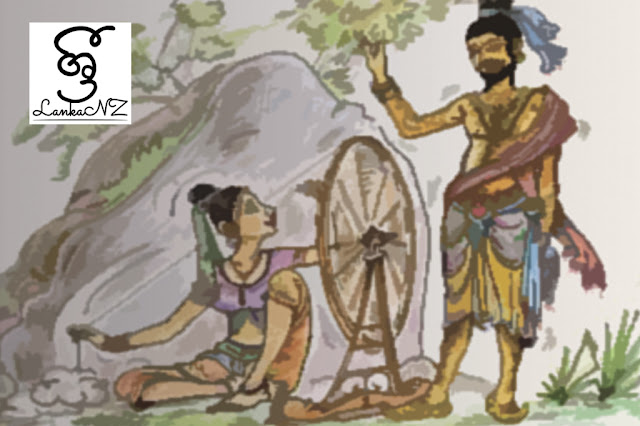Early footsteps of the Sinhale- continued…..

The Sakya connection
The ancient ruins and artefacts found in Sri Lanka speak of a civilization spanning at least 40,000 years. Archeological findings give us a sketch of what this civilization must have been like, while folklore, stone inscriptions and landmark writings and the like add flesh and colour to the sketch.
The continuation and evolution of this civilization carried on to meet a remarkable event in the year 543 BC when Indo-Aryans arrived on the scene. In our last reverie we mentioned how a Prince named Vijaya (possibly) from the neighboring State of Vanga, arrived on the shores of Lanka with a troupe of 700 subordinates and settled in the pearl shaped island. Britannica says that linguistic affinities between the early Sinhalese- and Prakrit-speaking peoples of eastern India strengthen the hypothesis of a migration from this area.
 |
| The consecration (coronation) of Prince Vijaya (Detail from the Ajanta Caves Mural of Cave No 17) |
Global setting at the time
We are continuing with Vijaya’s story, for it was he who laid the foundation stone for the civilization named Sinhala, in the island of Lanka. Like me, do you wonder what the rest of the world looked like at the time of Vijaya’s arrival? Let’s take a look outside the window of Vijaya’s palace and take in the back drop to this event.
The year 543 BC belongs to the 6th century BC, which starts on the first day of 600 BC and ends the last day of 501 BC. Who else was alive during this time and what were their stories- briefly?
The 6th century BC, popularly known as the Axial Age as defined by the philosopher Karl Jaspers, represents a significant peak in human history. This period saw the prominence of five major civilisations in four different parts of the world:
1. The Buddha and Mahavira lived in India; they founded Buddhism and Jainism respectively. As we studied in our primary classes this was arguably the height of Indian civilization with resplendent royal dynasties, famous universities such as Nalanda where great scholars and thought leaders such as the Buddha (“Siddharth Gautama”) and Mahavira debated matters of high intellect, agriculture and fine arts were at a great height and kings ruled with great wisdom and panache! In the neighboring Lanka, in 543 BC, at the time of Vijaya’s arrival, there seems to have been an advanced society in Lanka where girls sat and weaved cotton, like Kueni did when she met Vijaya; women adorned themselves in fine jewellry and fine clothes for their wedding ceremony, like Kueni did- all this information (though unintentionally) comes through the Mahawansa chronicle. Mahawansa also mentions that on the night of Kueni – Vijaya wedding, a local leader was also getting married; the grand celebration took place that evening replete with fine music and singing. All these are undeniable features of a sophisticated, civilized, well-to-do society- not a nomadic, uncivilized one. There is archeological evidence that during the pre-historic Iron Age (about 1000 BC) Lanka had a parallel development with India in the use of iron – this was evident through excavations done both at Anurdhpura by the Cambridge University as well as excavations done by Kelaniya University in the Sigiriya area. In the 600 BC the inhabitants of Lanka were also known to have used a flat tile made out of clay/ terra cotta to tile their roofs.
2. In West Asia, the Babylonian rule was ended in the 540s BC by Cyrus, who founded the Persian Empire in its stead. The Persian Empire continued to expand and grew into the greatest empire the world had known at the time. During the Persian empire, Zoroaster, also referred to as Zarathustra, founded Zoroastrianism, a dualistic philosophy. The Olmec civilization declined in Central America and in 547 BC Croesus, Lydian King, is defeated by Cyrus of Persia near the River Halys. Cyrus completed his conquest of Lydia in 546 BC, and made Pasargadae his capital. Further, in 540 BC, Persians conquered Lycian city of Xanthos, now in southern Turkey.
 |
| Tomb of Cyrus in Pasargadae- Today it is an archaeological site and one of Iran’s UNESCO World Heritage Sites, about 90 kilometres to the Ancient Greece |
3. Greek philosophy and political systems flourished during the 5th century BC. In 540 BC the Greek city of Elea of southern Italy was founded. Pythagoras made influential contributions to philosophy and religious teaching in the late 6th century BC. He is often revered as a great mathematician, mystic and scientist, but he is best known for the Pythagorean theorem which bears his name. Further greats in this period in Greece were Anaximander- a pre-Socratic Greek philosopher and his master Thales. Anaximander succeeded Thales and became the second master of that school where he counted Anaximenes and, arguably, Pythagoras amongst his pupils.
4. East Asia (China) was resplendent with great philosophers and mighty royal dynasties. Confucius turned himself into an expert on the literature and history and poetry of an earlier age in China, and with that he created his own doctrine. The purpose of the doctrine was to restore peace and order. The time in which he lived was a time of war and conflict in China between numerous feudal states, and he believed he had devised a doctrine of virtue that could bring prosperity back to China. In addition to Confucianism, Legalism and Moism flourished. Laozi founded Taoism. King Jing of Zhou became King of the Zhou Dynasty of China.
Last but not least, the Iron Age Europe saw the Celtic expansion in progress.
The silk route that connected Europe with Asia and Persia was still a long way off- not formed till 130 BC, established when the Han Dynasty in China officially opened trade with the West.
Where does Lanka’s Great King Ravana fit in– when was he around?
A king called Ravana is mentioned in folklore and this king is one of 3 main characters of a major Sanskrit epic of ancient India called Ramayana. Along with the Mahābhārata, the Ramayana forms the Hindu Itihas or history. According to Hindu tradition, Ramayana takes place during a period of time known as Treta Yuga. Treta Yuga is the second of the four yugas, or ages of mankind, in the religion of Hinduism. These four yugas or periods are Satya Yuga, Treta yuga, Dvapara Yuga and Kali Yuga. The ‘bull of Dharma’, according to Hinduism, symbolises morality. This bull, according to legend, had all four legs in the Satya Yuga, stood on three legs during the treta yuga, had two in the succeeding Dvapara Yuga. Currently, in the immoral age of Kali, the bull (morality) is said to stand on one leg. Perhaps some of us can relate to this concept.
Now we want to know the timing of King Ravana- Treta means ‘a collection of three arousing things’ in Sanskrit, there were three Avatars of Vishnu that were seen, the fifth, sixth and seventh incarnations as Vamana, Parashurama and Rama respectively. The name could also be derived from the fact that the Treta Yuga lasted 3,600 divine years, or 1,296,000 human years. If the treta yuga lasted 1,296,000 human years, the Ramayana is based in an incredibly distant time period, that we have no hope of going back to. However, the possibility that someone like Ravana could have existed in Lanka is not to be diminished; so-called ‘artistic license’ is such that Valmiki who wrote Ramayana during the 5 century BC could have conjured up his King Ravana character after a real legendary king of Lanka who ruled earlier in the 7th or 8th BC perhaps!
Just because we love our King Ravana does not mean that Prince Vijaya needs to be a lie or vice versa. Craving to celebrate Ravana does not create a need to defame Vijaya and the distinct civilization he created. We are today all the richer for all those who contributed to the journey. We denounce Prince Vijaya and we lose the right to be Sinhela!
As we mentioned in our last musing, Vijaya who turned his back on his Kueni and married a princess from India, ruled Lanka for 38 years but died without an heir! Nothing is known of Vijaya’s children- son Jeevahatta and the daughter Disala who upon their mother’s death were last seen heading towards Sabaragamuwa. While Mahawansa tells that Kueni was killed by her Yakkha Gothric relatives legend has it that Kueni jumped off Yakdessa Gala, imploring the Gods to curse Vijaya for abandoning her – so that no child of Vijaya would ever sit on the throne of Lanka!
 |
| A fresco from ‘Sinhalavadana’ in Ajantha Caves depicting the enticing of the Prince by Kuveni |
Before his death Vijaya sent for his younger brother at Sinhapura to come and take over his reign. This did not happen for unknown reasons but he sent his youngest son, Panduvasudeva, to Sri Lanka. Panduvasudeva landed at Gokanna (now Trincomalee) on the east coast, with 32 followers. He was enthroned at Upatissagama and continued the Vijaya dynasty from 504 BC to 474 BC. He was the first monarch of the Kingdom of Upatissa Nuwara succeeding Upatissa (a minister of Prince Vijaya who arrived with him) who reigned as regent. Upatissa Nuwara was said to be seven or eight miles further north of the previous capital Tambapaṇṇī, which is present-day Puttalam.
Panduvasudeva married an Indian princess, Badrakatchchayana, who according to legend was an unmatched beauty. Badrakatchchayana was the grand-daughter of Amithodana Sakya, who in turn was the brother of King Suddhodana- the King of Kapilawasthupura, the father of the Prince Siddhartha Gautama and a descendant of King Jayasena. In other words, Sinhale’s royal blood line comes from the union of Prince Panduwasdeva (Vijaya’s nephew) and Badrakatchchayana- who was Siddhartha Gautama or the Buddha’s niece!
Queen Bhadrakatchchayana and her brothers had arrived in Sri Lanka and built their own settlements – Vijitha built Vijithagrama, Anuradha Anuradhagrama, Diga Digagrama and Rohana Rohanagrama. King Panduvasdeva and Bhadrakatchchayana had seven sons, including Abhaya, Tissa and the only daughter was Citta/ Chitra. The daughter Chitra inherited her mother’s celestial beauty and as she grew into a maiden she earned fame as ‘unmaada Chitra’ (maddening Chitra).
That itself would have been the height of happiness for the royal couple- but, astrology cast a shadow on that bed of roses reminding of the dukkha that underlines the sansaric journey! There was an astrological prediction at Chitra’s birth that the princess would bear a child who would kill his seven uncles and become the King of Lanka.
When Chitra’s brothers came to know of the prediction they wanted their sister dead. However the father King Panduwasdeva disagreed and built a one bedroom chamber on top of a pillar. Princess Chitra and her retinue were confined to this Ek Tam Ge to prevent any liaison which would result in the birth of a son. Anyone visiting Panduwasnuwara even today can see the partly restored King Panduwasdeva’s palace and Chitra’s chamber which was known as the Ek Tam Ge.
According to Mahawamsa, Gamini, Diga’s son, was sent to King Panduwasadeva and Queen Bhadrakatchchayana (whose nephew he was) to perform royal service- or was it a pre-cursor to an arranged marriage? Mahawansa records that a union took place between Diga Gamini and Chitra resulting in the birth of a son, prince Pandukabhaya.
Historian, Prof. Mendis Rohanadeera thinks that the story given in the Mahawansa is a cover up of the real paternity of the child.
According to Prof. Rohanadeera ancient chronicles state that the entrance from the King’s bedchamber to the Ek Tam Ge was guarded by a close associate of the King – Chitre and his friend Kalavela, who were of the indigenous gothric clan- people of Kueni.
When the Kueni’s Yakkha people were defeated by Vijaya and his troops 70 years earlier they had fled to the hills awaiting a chance for revenge.
After the conquest of the locals, Vijaya built his settlements, and Badhrakatchchayana’s brothers their own, in different areas. Constant quarrels between the two forces were the norm. The locals or Yakkas were caught in between and lived in hiding in Dimbulagala and Ritigala.
Since their defeat at the hands of Vijaya, the Yakkas had been searching for ways to become rulers once again. When they heard of the prediction made by the royal astrologers, they set about making plans that Chitra’s son should have Gothric paternity. Kalawela and Chitre, entered into palace service at about the time Diga’s son Gamini did.
In the second generation, there is evidence that Yakkha clan fairly freely found employment in the Aryan palace; Princess Chitra’s personal servant, Chethiya, was also of the fierce Yaksha clan.
The story goes that Diga Gamini may have gained access to Chitra’s chamber by ordering Chitre or Kalawela to let him pass. Meanwhile, Munidasa Cumaratunga’s theory was that Gothric leader Chitre may have had a relationship with the Princess who then begot a son belonging both to the Gothric clan as well as to royalty. The infant, soon after birth was smuggled out of the palace and replaced with a baby girl born to a Yakka gothric couple. Thereafter, it was the Yakkha aborigines who brought up Prince Pandukabhaya.
Cumaranatunga’s theory has more appeal considering that as soon as the baby boy was born he was smuggled out and a baby girl born to the Yakkha clan was brought in to replace him. If the baby was that of Diga Gamini and Chitra of the Sakya clan alone it is unlikely that the palace would have been fooled by the replacement of the infant with a Yakka baby. The Yakka girl and baby Pandukhabhaya both would have stood out like sore thumbs in their respective environments as they would have had totally alien features.
The King’s sons, on hearing that Chitra had conceived a child, ordered that Chitre and Kalawela be put to death for not having carried out their duties of guarding the Princess. It could also mean that Chitre was put to death because of his connection with Chitra. But the truth lies buried in the dim mists of time. The legend continues that Chitre and Kalawela were reborn as Yakkas, who protected the young Prince. Myths and legends are great sources of human cultural heritage. They show the dramas of human life.
Thus was born a Prince claiming bloodlines to the Vijaya dynasty, Gothric Yakkha heritage and the Sakyan dynasty of India, ideally suited to be the king of Lanka.
The Sakya connection given in the Mahawansa was forgotten for 1500 years, until the 10th century. Various inscriptions were discovered in Ruhuna, Ratagamuwa and Pissomulle near Kirinda. The writings of Mihindu Epa, son of Kassapa the 5th state, “I am of Sinhala origin descended from Pandu Aba who comes from the great Suddodana’s purest clan.” These inscriptions indicate that the Sinhala people originated from Pandukabhaya.
When Prince Pandukabhaya came of age and planned to attack his uncles, the eldest of the uncles sent him a message not to wage war but to rule the area from Dimbulagala to the deep south of Ruhuna. Pandukabhaya did not heed his uncle but he did not kill his oldest uncle.
Pandukabhaya took water from the Abhaya Wewa which he constructed and consecrated himself. He planned the city of Anuradhapura. Anuradhapura was later developed as a city by Pandukabhaya.He also introduced the local government system to Sri Lanka and ordered different areas to barter trade with each other.
During his time there were the Jains, the Veddhas with their own King and the Kumbandans. He gave them a place to live and carry out their customs.
Pandukabhaya was succeeded by his son Mutasiva, and he, by his son King Devanampiyatissa. King Devanampiyatissa’s grandson was King Dutugemunu. We will meet next time with more stories on these ancestors in a next episode…..







